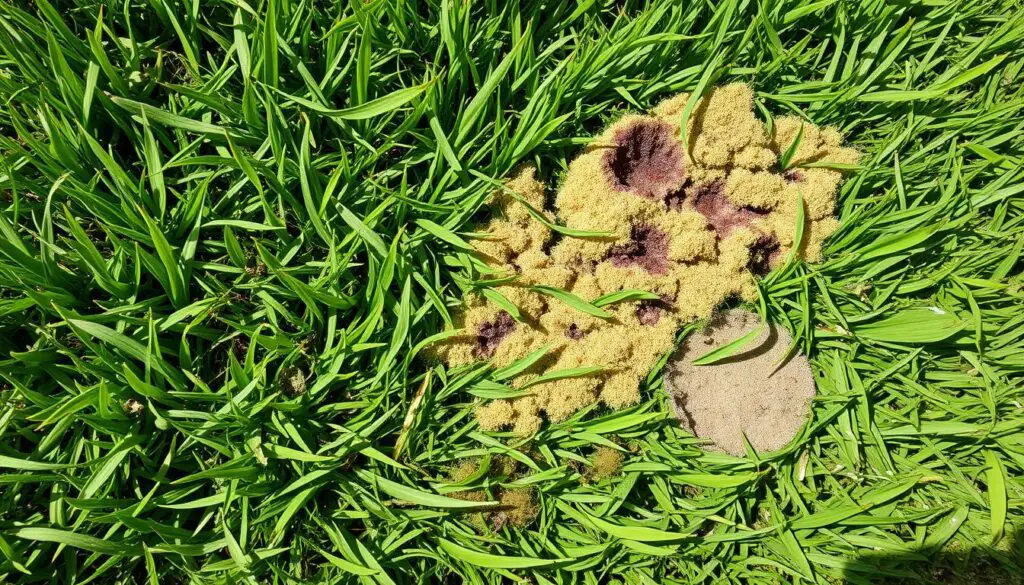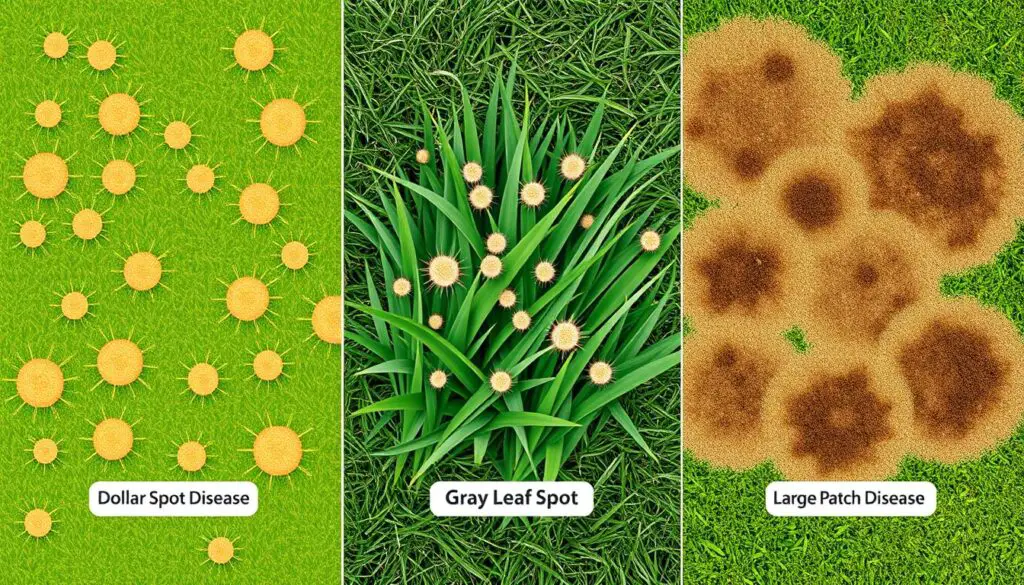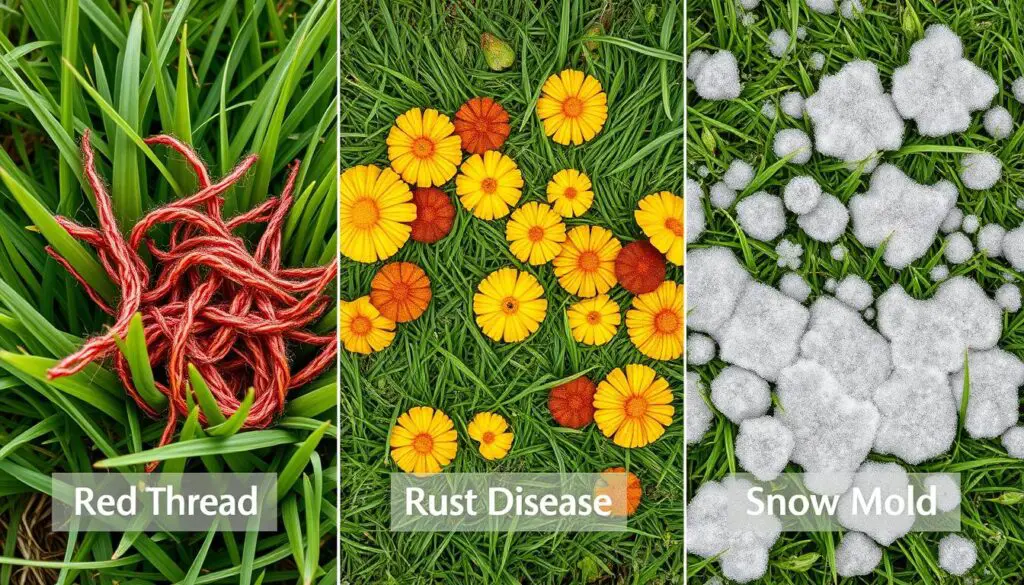How to Identify and Treat Lawn Diseases

Did you know dollar spot lawn disease is common in the United States? It’s important to know how to spot and treat lawn diseases to keep your lawn healthy. In this guide, I’ll teach you how to identify common lawn diseases and treat them effectively.
You’ll learn about cultural control methods and fungicides to fight lawn diseases. We’ll cover warm-season and cool-season diseases like Brown Patch and Dollar Spot. I’ll also share tips on choosing the right grass and when to seek professional help. By the end, you’ll know how to keep your lawn disease-free.
Key Takeaways
- Lawn diseases can harm your lawn’s health and look.
- Spotting disease symptoms early is key to treating them right.
- Using cultural methods and fungicides can fight diseases.
- Choosing the right grass and good lawn care prevent diseases.
- Fixing a damaged lawn might need overseeding and aeration.
Common Lawn Disease Symptoms
Spotting the signs of lawn disease is key to fixing it. Look out for these common symptoms:
Brown Patches and Rings
Brown patches or circular rings of dead grass can be small or huge. They’re often due to fungal diseases like brown patch. This disease loves hot, humid weather and harms grasses like tall fescue and perennial ryegrass.
Yellow or Thinning Grass
Yellow, thinning, or uneven grass can mean a few things. It might be due to not enough nutrients, bad watering, or diseases like dollar spot or summer patch. Watching for these signs can help find the problem.
Fungal Threads or Powdery Growth
Fungal threads or powdery growths on grass blades are a clear sign of disease. They might show that conditions are ripe for diseases like grass rust or red thread.
By keeping an eye out for these symptoms, homeowners can tackle lawn diseases early. This helps keep the lawn healthy and green.
Identifying Specific Lawn Diseases
After spotting general signs of lawn disease, it’s time to find out what’s causing it. Common culprits include brown patch, dollar spot, and gray leaf spot.
Brown Patch
Brown patch shows up as large, irregular brown spots. These spots can be several feet wide and look wilted. It loves hot, humid weather and spreads fast.
Dollar Spot
Dollar spot creates small, circular spots, about the size of a silver dollar. These spots look bleached and can grow into bigger areas. It’s common in cool-season grasses like Kentucky bluegrass and perennial ryegrass.
Gray Leaf Spot
Gray leaf spot causes small, bleached spots with dark edges. It thrives in warm, humid weather and spreads quickly. This disease is a big problem for warm-season grasses like Bermuda, Zoysia, and St. Augustine.
Knowing exactly which disease you have is key to treating it right. Grass type, weather, and other factors play a big role in lawn diseases.

Warm-Season Lawn Disease Culprits
Keeping your lawn lush and vibrant is a constant fight against diseases. Warm-season grasses like Bermuda, St. Augustine, and Zoysia face many challenges. Knowing the common culprits is key to treating these issues well.
Dollar Spot is a common disease that affects both warm-season and cool-season grasses. It thrives from late spring to late fall, causing circular, straw-colored patches. Gray Leaf Spot is another big problem, mainly in new turf, causing a lot of damage to the leaves.
Large Patch is a fungal disease that creates big, brown patches. Take-All Root Rot weakens the grass’s roots, making it look thin and discolored.
To fight these diseases, it’s important to know which one is affecting your lawn. Choosing the right fungicide, like Azoxystrobin, Propiconazole, or 1,3-Dioxolan-2-one, 4-methyl, can help control the disease.
| Warm-Season Lawn Disease | Symptoms | Effective Fungicides |
|---|---|---|
| Dollar Spot | Circular, straw-colored patches | Azoxystrobin, Propiconazole |
| Gray Leaf Spot | Extensive damage to foliage | Propiconazole, 1,3-Dioxolan-2-one, 4-methyl |
| Large Patch | Large, circular or irregular-shaped brown patches | Azoxystrobin, Propiconazole |
| Take-All Root Rot | Thin, discolored appearance | Azoxystrobin, Propiconazole |
By knowing these diseases and using the right treatments, you can keep your lawn healthy and vibrant. This way, your lawn will thrive during the warmer months.
Cool-Season Lawn Disease Threats
As the seasons change, cool-season grasses face unique disease challenges. These include tall fescue, Kentucky bluegrass, and perennial ryegrass. Unlike warm-season lawns, cool-season grasses deal with different fungi and stressors. Knowing the common cool-season lawn diseases and how to spot them is key to a lush, healthy lawn all year.
Red Thread
Red thread is a common cool-season lawn disease. It shows up as reddish-pink threads on grass blades. This fungus loves cool, humid weather, often hitting in spring and fall.
To fight red thread, keep your grass at the right height. Water deeply but not too often. Also, use fungicides early in the season if needed.
Rust Diseases
Rust diseases cause yellow or orange patches on grass. These fungi weaken the grass, making it thin and discolored. To beat rust diseases, mow right, fertilize well, and manage your lawn’s environment.
Snow Mold
Snow mold grows under snow, creating gray or pinkish patches. It waits until spring to show itself. To tackle snow mold, remove excess thatch and debris. Also, use fungicides if the problem doesn’t go away.
By watching for and tackling these diseases, you can keep your lawn healthy all year. Spotting red thread, rust diseases, and snow mold early and treating them right will make your lawn look great.
Lawn Disease Treatment
Dealing with lawn diseases needs a mix of cultural control and fungicides. Homeowners can stop and prevent diseases by using the right methods. This keeps lawns healthy and looking good.
Cultural Control Methods
Cultural control makes the lawn less welcoming to diseases. It includes mowing right, watering on schedule, and using the right fertilizer. Aerating, managing thatch, and fixing drainage also help.
These steps make the lawn strong and less likely to get sick. A healthy lawn is easier to care for.
Fungicide Applications
For serious diseases, fungicides are needed to fight the fungus. It’s important to pick the right fungicide for the disease and grass type. Using Patch Pro or Systemic Fungicide RTS can help control many diseases.
How often to use fungicides depends on the disease’s severity.
Treatments every 7 to 14 days, with at least 2 applications, might be needed. Also, using fungicides before rainy seasons or when there’s too much nitrogen can prevent diseases.
Combining cultural control and fungicides keeps lawns disease-free. Regular checks, fixing conditions that attract fungi, and keeping the lawn healthy are essential. This way, homeowners can enjoy a disease-free lawn.

Lawn Disease Prevention Strategies
To keep your lawn healthy and disease-free, you need to act early. Good lawn care practices can lower disease risks. Here are key steps to prevent lawn diseases.
Proper Mowing and Watering
Mowing your lawn right and using sharp blades helps it stay strong. Don’t cut more than one-third of the grass height at once. Also, deep, less frequent watering helps avoid fungal growth. Avoid too much water, as it can attract disease.
Fertilization and Soil Management
Using the right fertilizer strengthens your grass against diseases. Make sure your soil’s pH and nutrients are just right. Regular soil tests and adjustments can greatly help prevent diseases.
- Proper mowing techniques, including maintaining the recommended grass height and using sharp blades, can help reduce stress on the grass.
- Deep, infrequent watering can discourage disease growth by avoiding excess moisture.
- Balanced fertilization and maintaining optimal soil pH and nutrient levels can bolster the grass’s natural resistance to fungal pathogens.
By following these lawn care tips, you can have a beautiful, disease-free lawn for many years.
“Proactive lawn care is the key to a healthy, disease-resistant lawn. By mowing, watering, and fertilizing properly, you can create an environment that discourages fungal growth and protects your investment.” – Sam, lawn specialist
lawn disease treatment
Dealing with lawn diseases needs a mix of cultural control and fungicides. Keeping your lawn well-mowed, watered, and fertilized helps prevent diseases. Also, fixing issues like soil compaction and poor drainage is key.
For tough cases, fungicides can be used to fight fungal infections. It’s important to pick the right fungicide based on the disease, grass type, and weather. On average, treating a lawn with fungicides costs about $40 for a 5,000 square foot area.
| Lawn Disease Treatment Product | Application Rate | Cost per Application |
|---|---|---|
| Humic12 | 6 oz per 1,000 sq ft every 14 days | $10 per 1,000 sq ft |
| MicroGreene | 6 oz per 1,000 sq ft every 14 days | $10 per 1,000 sq ft |
| Air8 Soil Conditioner | 6 oz per 1,000 sq ft | $5 per 1,000 sq ft |
| D-Thatch | 9 oz per gallon | $15 per gallon |
For diseases like brown patch, avoid too much nitrogen. Instead, use a balanced mix of fungicides, soil conditioners, and micronutrients. This helps your lawn get healthy again.
Knowing the disease, grass type, and weather helps create a good treatment plan. This way, you can fix lawn diseases and make your outdoor space beautiful and healthy again.

Choosing Disease-Resistant Grass Varieties
Choosing the right grass varieties is key to a lush, healthy lawn. Opting for disease-resistant grass can greatly reduce lawn disease risks. This also means less need for treatments.
Some grasses are naturally better at fighting off diseases. For example, certain tall fescue and Kentucky bluegrass are more resistant to brown patch and dollar spot. Picking the right grass for your area can help your lawn fight off diseases better.
| Grass Type | Climate Adaptability | Disease Resistance | Drought Tolerance | Shade Tolerance |
|---|---|---|---|---|
| Tall Fescue | Cool-season | Excellent | Good | Moderate |
| Kentucky Bluegrass | Cool-season | Good | Moderate | Poor |
| Zoysia Grass | Warm-season | Excellent | Excellent | Good |
| Bermuda Grass | Warm-season | Good | Excellent | Poor |
| St. Augustine Grass | Warm-season | Moderate | Moderate | Excellent |
When picking disease-resistant grass, think about your climate, soil, sun, and how much you use your lawn. Making a smart choice can lead to a lawn that fights off diseases well. This means fewer fungicides and lower lawn care costs.
“Investing in disease-resistant grass varieties is a proactive step toward a thriving, low-maintenance lawn.” – Laura, lawn health enthusiast
As turfgrass science advances, we’ll see grasses that can handle climate changes and new diseases better. By staying up-to-date and choosing wisely, you can have a beautiful, low-maintenance lawn. It will be a great place to relax for years.

When to Call In Professional Help
Keeping your lawn healthy and lush is important. Many lawn diseases can be managed with the right care. But, sometimes, you need a pro’s help. If the disease is bad, keeps coming back, or you’re not sure what to do, a professional lawn care expert can be a big help.
These pros know how to find and fix the problem. They have the right tools and products for the job. They can also teach you how to keep your lawn healthy in the long run.
Here are some signs you might need a pro:
- Persistent or recurring brown patches, despite your best efforts
- Large areas of dead or thinning grass
- Visible fungal growth or other disease symptoms
- Slow or stunted grass growth
Working with a certified professional lawn care provider means your lawn gets the best care. Don’t wait to ask for help. It’s worth it to save time, money, and the sadness of a sick lawn.
“Hiring a professional company can ensure the use of effective products for treating lawn diseases.”
A healthy lawn fights off diseases well. With the right advice, you can have a beautiful lawn everyone will admire. So, don’t be shy to call in the experts when your lawn needs extra care.
Restoring a Disease-Damaged Lawn
When your lawn gets hit hard by disease, it’s time to act. You can revive your turfgrass with a mix of overseeding, aeration, and lawn renovation. These steps can bring your grass back to life.
Overseeding and Aeration
Start by overseeding with disease-resistant grass seed. This fills in bare spots. Before you seed, aerate your lawn. Aeration makes the soil better for roots to grow.
For more info on aerating, check out this link.
Lawn Renovation Techniques
For severe damage, you might need a full lawn renovation. This means tilling, adding new topsoil, and reseeding. A thorough approach can make your lawn healthy again.
| Lawn Restoration Method | Key Benefits |
|---|---|
| Overseeding | Fills in bare or thinning spots with disease-resistant grass seed |
| Aeration | Improves soil conditions and root growth to support a healthy lawn |
| Tilling and Topsoil Addition | Allows for a complete lawn renovation, addressing severe disease damage |
Being proactive with lawn care can help your grass bounce back. It might take time, but with patience and the right care, your lawn will be lush and vibrant again.
“The secret to a healthy, thriving lawn is in the details. Careful attention to overseeding, aeration, and renovation can make all the difference in restoring a disease-damaged lawn.” – Sam, author of the blog
Organic and Natural Lawn Disease Remedies
As a homeowner, I’ve found organic and natural remedies for lawn diseases. These include using beneficial microorganisms and horticultural vinegar or essential oils. I also add compost or other organic soil amendments. These methods help my lawn become stronger and healthier over time.
Using horticultural vinegar is a natural solution I’ve found effective. It treats light to moderate lawn fungus when mixed with water. Baking soda is another option, mixed with oil and liquid soap in water. But, be careful not to use too much baking soda, as it can harm the grass.
I’ve also started using beneficial microorganisms and organic soil amendments. These not only fight fungal issues but also make my lawn stronger. By choosing these organic remedies, I keep my lawn green and reduce environmental harm.
FAQ
What are the common visual signs of lawn disease?
How can I identify the specific lawn disease affecting my grass?
What lawn diseases are common in warm-season grasses?
What lawn diseases threaten cool-season grasses?
How do I treat lawn diseases?
What are some effective strategies for preventing lawn diseases?
When should I consider calling in a professional for lawn disease management?
How can I restore a lawn that has suffered from disease damage?
Are there any organic or natural remedies for lawn diseases?
Source Links
- https://www.groundsguys.com/blog/2022/july/how-to-identify-and-treat-different-types-of-law/
- https://www.pennington.com/all-products/grass-seed/resources/keep-your-lawn-free-from-fungal-disease
- https://productiveparks.com/5-common-fungal-lawn-diseases-and-how-treat-them
- https://scotts.com/en-us/how-to/how-to-identify-lawn-diseases.html
- https://weedman.com/blog/common-lawn-diseases
- https://www.thegrassmaster.com/lawn-care-101/disease-identification/
- https://vinedresserlandscaping.com/fungicides-for-warm-season-grasses/
- https://covingtonnaturals.com/blogs/news/lawn-grass-fungus-identification-pictures?srsltid=AfmBOoph-DDRLl5lmx3-O3e6OMB8hnthxuIHDivpQXThWVax3bECzEVd
- https://www.lawnstarter.com/blog/lawn-care-2/summer-patch-lawn-disease/
- https://www.mainelygrass.com/blog/lawn-disease-your-guide-to-red-thread
- https://thelawncarenut.com/blogs/news/how-to-cure-lawn-disease-problems?srsltid=AfmBOooKbH9ioYN375-iLo88DyFkwSlLFIIR_nYs8XyC61MWih_YtfG0
- https://www.solutionsstores.com/lawn-disease-control?srsltid=AfmBOoo8hPCMX1mPPgUxXA4WevoID_NxOaTl8gP6su7MkTNifXNanZTd
- https://sodlawn.com/lawn-disease-prevention-control/?srsltid=AfmBOor-_6DU6q1EhKGr92UMVFocc7s_ueQTR9w_ZTR2Ok6dW1lwzNSn
- https://www.savatree.com/lawn-disease-treatment.html
- https://thelawncarenut.com/blogs/news/how-to-cure-lawn-disease-problems?srsltid=AfmBOoqoTM7fgCuFxUSMHnm4CKVgBs15PiGcazh5YpCWiPcUPxyKMvYf
- https://lawnlove.com/blog/how-to-identify-and-treat-grass-fungus/
- https://backyardnomads.com/disease-resistant-grass-types
- https://theturfgrassgroup.com/lawn-care-tips/a-green-guide-preventing-and-managing-lawn-grass-diseases/
- https://apluslawn.com/blog/dont-try-to-treat-a-lawn-disease-on-your-own-instead-call-in-the-pros/
- https://www.greensolutionslpc.com/lawn-disease-control/
- https://www.spring-green.com/learn/blogs/blog-identify-repair-lawn-disease/
- https://naturaltree.com/2024/07/09/preventing-and-repairing-lawn-disease-damage/
- https://americanlandscapesllc.com/lawn-fungus/
- https://naturalawn.com/lawn-care-tips/how-treat-brown-patches-your-yard
- https://nexgreen.com/effective-strategies-to-combat-summer-lawn-diseases/

